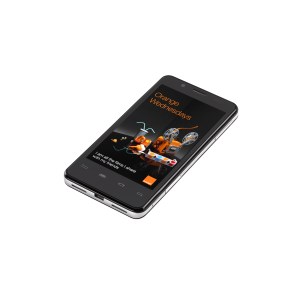Sunday, February 26, 2012
Meet Intel’s Newest Smartphone, A Low-Cost Device Designed For Orange In Europe

The next step in Intel’s ambition to become a central player in the mobile ecosystem is dovetailing with mobile carrier Orange’s strategy to grow its line of own-brand smartphones.
At MWC, the two are together announcing a new device, code-named “Santa Clara”, which will be Intel’s first handset for the European market, and the most ambitious own-branded device yet rolled out by Orange.
The phones will join a handful of other smartphones being built with Intel technology inside, including a confirmed device from Lenovo.
Orange says that the official name and price of its new device will be revealed later this year, when the phone actually comes to the market.
But for now here are some of the most notable things about it: it will run Android Gingerbread with plans to upgrade to Ice Cream Sandwich; it’s in the vein of the slimmed-down/specced-up handsets we’ve seen coming from the likes of HTC, LG and others; and it will be looking to make a mark mainly by selling itself as an “affordable” smartphone — part of the growing trend that we are seeing to offer cheap, but still high-end, devices.
Orange’s deputy VP of devices, Patrick Remy, calls the plan a “democratization” of the smartphone trend, and its main aim is to target those who can only “afford the entry level of contract tariff plans.”
This is an important and probably smart move by the carrier, owned by France Telecom: Yes, Orange has operations in some of the more advanced mobile markets in the world, such as the UK and France, but it also has significant operations in emerging markets, too, in regions like Africa.
Those are markets where cheap smartphones may be the only smartphones that will really sell for the near future. While the “Santa Clara” will initially be rolled out in the UK and France, if all goes well, Orange says that eventually it wants to extend that to the rest of its footprint.
Equally, low-end is where Orange actually has a chance to make a mark. With the number of high-end (read: pricey) devices coming from established players like Samsung and HTC, not to mention the many handsets we’re seeing from ambitious new entrants like ZTE and Huawei — all targeting a market that is in many instances dominated at the moment by Apple and its iPhone — where, exactly, does a carrier with ambitions to do more than just sell network time get a look in?
On the other hand, the track record so far with Orange’s own-branded handsets has been slow — but not a failure.
Orange has plugged away at making its own-branded devices for a decade already — starting with the very first-ever smartphone built on a Microsoft platform (the frustrating SPV, quietly made by HTC, and branded as Orange).
Then there was a fallow period of few devices until Android came along and breathed life into the idea again in 2010. In Q4 2011, the company said that across its footprint 15 percent of all the smartphones it sold were own-branded devices, up from 7 percent in Q4 2010: a sign that if Orange prices the devices right, and markets them the right way, it can get somewhere. Its target for 2012 is to grow that proportion by 20 percent more.
That is something that has encouraged it to take it one step further. Partnering with Gigabyte as the ODM, the “Santa Clara”, it says, will be a “high performance” device, despite the lower price.
Based on Intel’s smartphone reference design and powered by its Atom Z2460 processor, the device will support HSPA+ (no LTE in the UK and France yet) — also using Intel technology. The two companies claim this will give the phone impeccable battery life while maintaining fast performance. It will also offer HD video and audio support, and an eight-megapixel camera that can take quick bursts of snaps, speaking to the papparazzo in all of us.
Not only do Orange devices offer a route to the carrier getting a better return and margin per subscriber, but they also offer a way for Orange to push its other services — those that have been a challenge for Orange to promote on platforms like iOS and Android where so many competing services exist. These will include quick links to Orange TV, Daily Motion (in which Orange has a 49 percent stake), Deezer (in France only), Orange’s film offers Orange Wednesdays, Your Orange and Orange Gestures.
Will that be enough to bring in the punters? I have to admit, the phone looks nice, but Murphy’s law did strike during my own time with it: we couldn’t get it to load a single page of the mobile web until just as I was about to leave my briefing.
A blip or a bigger issue of the device not quite ready for prime time? We’ll have to wait until later this year to see.















0 comments:
Post a Comment